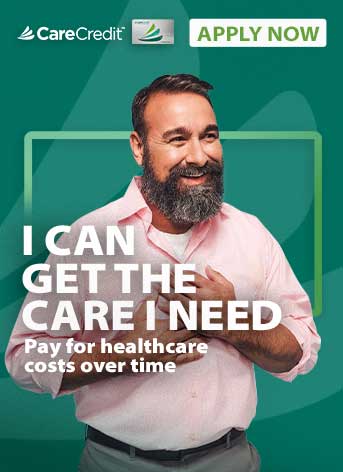Prescription costs can make up a substantial part of your budget, especially if you take several medications. According to a recent Synchrony study, Lifetime of Healthcare Costs in the U.S., insured Americans routinely underestimate their healthcare costs, spending almost 1.5 times more per year than they estimate or plan for.1
However, by doing some research, taking advantage of the various discount programs available and working with your healthcare providers and health plans, you may be able to significantly lower your out-of-pocket costs for prescription medication.
Here are nine tactics to help you reduce your out-of-pocket cost when purchasing prescriptions.
1. Use the CareCredit Credit Card
Did you know you can use your CareCredit credit card nationwide at our pharmacy-and-prescription network locations?* This includes Walgreens, Walmart, Rite Aid and Sam's Club.** Use the CareCredit credit card to help pay not just for prescriptions but also for flu shots, immunizations, over-the-counter (OTC) medications, deductibles, copays and coinsurance for you and your family.
2. Use Preferred Pharmacies
Check if your health insurance plan includes preferred pharmacies, which can lower your out-of-pocket costs. These plans negotiate agreements with partner pharmacies to charge less, similar to how going to an in-network health provider is less expensive than going out of network.2
3. Set Up Mail Order for a 90-Day Supply
If you have ongoing medication needs, consider switching to a mail-order program if it’s offered by your health plan. This lets you order and receive a three-month supply of covered prescription drugs directly to your home. This approach is typically more affordable than picking up a 30-day supply at your local pharmacy.2
4. Research Patient Assistance Programs
Patient assistance programs (PAPs), often sponsored by pharmaceutical companies, are designed to help underinsured or uninsured patients to afford their prescription medications.3 Some PAPs may also be sponsored by nonprofit organizations or government agencies.
Eligibility requirements and coverage vary widely across programs — there's no standardized qualification process. To find out if a PAP is available for your prescription drug, contact the drug manufacturer directly or check their website.4
Some PAPs offer full coverage of the medication cost, while others provide a discount or low-cost option. There may be limits to the benefits you receive, such as the amount of medication per month or how long the PAP lasts. Your doctor may also be required to fill out a portion of the application.
In addition, many states offer state pharmaceutical assistance programs (SPAPs) to help offset the cost of prescription drugs. Medicare provides a list of state pharmaceutical assistance programs on its website.4
5. Buy From Online Pharmacies
Just as with other purchases you make, shopping around for prescription drugs online may help you find better deals. Just make sure you're ordering from a reputable place.
One example of an online-only lower-cost pharmacy to explore is Cost Plus Drugs (founded by Marc Cuban). This pharmacy is unique in that it clearly lists the price you'll pay for each medicine on the website.5
To qualify, you'll need your care provider to write a new prescription to Cost Plus Drugs. You may also need to personally contact your pharmacy or your insurance company to determine what you'll be paying.5
6. Ask for Generic Drugs
Brand-name prescription drug costs vary widely, as does the amount of prescription drug coverage offered by many healthcare insurance plans.
If your doctor has prescribed a brand-name drug as part of your treatment plan, ask them if there's an equally effective generic formula and if switching is a safe option for you.
Americans saved around $408 billion in 2022 opting for generic prescription drugs over their brand-name counterparts.6
7. Inquire About Prescription Discount Cards
A prescription discount card, sometimes called a pharmacy discount card, offers reduced pricing on prescription medications when used within a network of participating pharmacies and is available to people with or without health insurance.
A popular example of this is if you’re a Costco member, you automatically have access to the Costco Member Prescription Program, which is a prescription drug discount card program that offers eligible Costco members and their eligible dependents lower prices on certain prescriptions.7
There are also third-party companies that offer these cards as well. There is generally no cost to use these cards, and for people without health insurance, prescription discount cards can significantly reduce the cost of medications.
Prescription discount cards can also be used by patients with health insurance, although discount cards and a health insurance copay cannot be used together. Some patients have reported, however, that for certain prescriptions, they received a better price with their pharmacy discount card than the health insurance copay.8
8. Find Manufacturer Coupons or Assistance From Drugmakers
Sometimes called copay coupons or copay assistance programs, manufacturer copay cards help offset the price of brand-name medications that do not have a generic equivalent. According to a government report, 95% of brand-name drugs offer manufacturer assistance.9
Copay cards reduce a patient's out-of-pocket expenses by sharing the cost of the medication between the patient's health insurance and the manufacturer. Patients can enroll in a manufacturer's copay program through the medication's website. Eligibility for a manufacturer's copay card generally requires you to have commercial or private insurance, and you cannot have government insurance such as Medicare or Medicaid.9
9. Get a Free Medication Review
Medicare offers a free service called Medication Therapy Management (MTM), which involves a pharmacist or healthcare provider reviewing your medications. The goal is to make sure that all medications you’re taking are necessary and interact safely, as well as identify any alternate options that might provide better outcomes.10
If you take multiple prescription medications from different providers, this is also something you can discuss directly with your primary care provider. In some cases, these reviews could reveal that you may be able to take fewer medications (or lower-priced versions), which can end up reducing your costs.
Managing Health and Wellness Costs With the CareCredit Credit Card
If you are looking for an option to help manage your health and wellness costs, consider financing with the CareCredit credit card. The CareCredit credit card can help you pay for the care you want and need and make payments easy to manage.* Use our Acceptance Locator to find a provider near you that accepts CareCredit. Continue your wellness journey by downloading the CareCredit Mobile App to manage your account, find a provider on the go and easily access the Well U blog for more great articles, podcasts and videos.
Your CareCredit credit card can be used in so many ways within the CareCredit network including vision, dentistry, cosmetic, pet care, hearing, health systems, dermatology, pharmacy purchases and spa treatments. How will you invest in your health and wellness next?
Author Bio
Dawn Papandrea is a journalist with more than two decades of experience covering personal finance and consumer issues. She has written for leading financial publications and organizations, including U.S. News & World Report, Investopedia, Bankrate and others.








